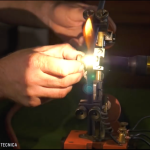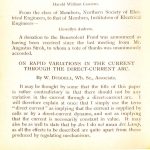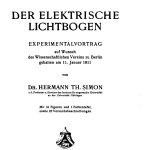Contributor Essays
The Speaking and Singing Arc
The Sound of Electricity at the Fin de Siècle
by Roland Wittje
February 19, 2018
Experiments reenacted by Paolo Brenni, Anna Giatti, and Roland Wittje (film by Antonio Chiavacci) at the Fondazione Scienza e Tecnica in Florence, July 2016
Electroacoustics around 1900
The rise of electrical technology and electromagnetic theory transformed acoustics into electroacoustics around the turn of the nineteenth to the twentieth century. It was then that the singing and speaking arc emerged as a scientific object, connecting electroacoustics directly to wireless technology and an increasingly popular electromagnetic worldview. Yet whereas the history of the telephone is well researched, the speaking or singing electric arc has fallen largely into oblivion.
Around 1900, carbon-arc lamps were widely used for street lighting and projection. Physicists William du Bois Duddell in London and Hermann Theodor Simon in Göttingen managed to tame the arc’s hissing and make it speak, listen, and sing. Its capacity to produce rapid electric oscillations, combined with its function as a loudspeaker and microphone, made the carbon arc a perfect candidate for wireless telephony through electric waves. What could be a better experimental system for acoustics in the electric age?
The singing and speaking electric arc became a popular demonstration experiment for physics classes in secondary schools, technical colleges, and universities in the first decade of the twentieth century, but it never took off outside the lecture room. The arc’s promises of sound amplification and wireless telephony, were fulfilled by a different device, the amplifier tube.
Reenacting experiments
Our reenactment of the experiments with the original apparatus (we used a set of instruments sold to the Istituto Tecnico Toscano by the German instrument maker Max Kohl) set out to address several questions that cannot be adequately answered by written sources. We wondered what it meant to do these experiments, which skills were required, and what aspects were critical and difficult. What did the arc sound like? What were its potential limitations? Despite our extensive experience in reenacting experiments around electromagnetism and wireless, almost every new experiment turns out to be a surprise and challenge—reworking the apparatus opens up a new set of questions that did not arise from our reading of the written and material sources. We wanted to share our experiences, sensations, and observations by producing a short video. Obviously, the 3′ 18″ video cannot document our two-week struggle to make the arc speak and sing; rather, it conveys what a student would have witnessed during a lecture demonstration of the speaking and singing arc. Instead of admiring the silent instrument behind glass, visitors to the Fondazione Scienza e Tecnica can now experience it in action.
What did we learn from our experiments?
I had written about Simon and the speaking arc, but I had never listened to one. Watching YouTube videos on present-day singing arcs revealed fundamental differences from the devices operated by Simon and his contemporaries. Today’s singing arcs work with high frequency, high voltage, low currents, and electronics, whereas the pre-electronic-age singing arc used continuous currents of 10 ampere and 100 volts. Making the arc speak or listen to us proved more challenging than we had anticipated. We had a number of documents with circuit diagrams and descriptions of the experiments, including a circuit hand-drawn by the retailer who sold the instrument to the Institute; publications by Simon, Duddell, and other scientists; a description by the Berlin instrument maker Ferdinand Ernecke; and Dr. Frick’s famous manual for experimenting in physics. The more we read, however, the more confused we became. Everybody seemed to have their own circuit setup and their own recommendations, but like a recipe, we had to stick to just one. The induction coil connecting the arc circuit to the telephone circuit puzzled us most. We never discovered exactly how it was wired. Opening it up to satisfy our curiosity would have meant destroying it.
One of our first tasks was to fundamentally review our understanding of electroacoustics. Working with 10 amps comes with its own risks, as we realized when we blew up a modern condenser. From then on, we only used historical components that were made to withstand such currents; any piece of modern electroacoustics would have been destroyed. Our current supply also proved insufficient. Around 1900, the large galvanic battery in the basement of the Institute would have powered our arc lamp with a smooth continuous current, but the rectified current of our own transformer was not at all continuous. The electric grid’s 50 Hz made themselves heard in both the arc and the telephone, thwarting our attempts to hear anything else. We had no choice but to buy enough automobile batteries to supply the required smooth continuous current.
Fed by the batteries, the arc immediately became very quiet. We realized that the sounds reproduced in the speaking arc were actually not particularly loud. The only way to distinguish between Paolo speaking or whistling into the carbon microphone and the reproduction of the sounds in the arc was to move the arc into the neighboring room. I had to learn how to constantly regulate and adjust the length of the arc. Only at a certain length would the arc start to vibrate and reproduce Paolo’s voice. The vibration itself would regularly extinguish the arc and I had to start again, bringing the carbon electrodes together, drawing the arc apart to a certain length, and fine-tuning. This revealed the experimental character of the speaking arc: its performance cannot be taken for granted.
The singing arc fared no better. To make the arc sing, we used an oscillating circuit composed of a condenser and a coil instead of a carbon microphone. We were able to produce pure whistling tones whose frequency we could change by altering the capacity of the condenser or the inductance of the coil. When we tried to film the experiments, we were unable to reproduce our results, until Paolo’s idea of placing the arc in a Bunsen burner flame resolved the problem. Despite, or maybe because of, these difficulties, we were fascinated by the faint sounds we produced. Performing the singing arc, especially, offered surprising insights into what the experiments actually meant in their day. Listening to the pure tone of the arc assured the experimenter that the oscillation was continuous and harmonic, while the pitch revealed its frequency.
Although we can learn a lot from reenacting historical experiments, like any other method it has its own characteristics and limitations. We do not inhabit the minds of our historical actors but interpret their experiments from our own perspective. Not only have knowledge and experimental practices changed, but the ways that we listen and what we hear (or don’t hear) must also be historicized. Once we understand this and avoid historical positivism, reworking experiments becomes a fascinating source of new historical insight, one that also offers new avenues for communicating the history of science in different ways and to wider audiences.











